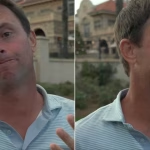This week, the spotlight of the golfing world will shine down upon Royal Portrush as the Northern Ireland links takes centre stage for the 148th Open Championship. With the tournament long sold out, over 200,000 people are expected to make the pilgrimage north this week for a tournament that has long been in the making.
It’s six years ago now since the then-R&A chief, Peter Dawson and his preferred course architect, Martin Ebert took a stroll around the Dunluce Links. At that point, an Open at Portrush was merely a pipe dream but Ebert’s vision transformed it into a distinct possibility. He pointed out to Dawson the majestic, towering dune land on which two new holes could be built to give the venue the space essential for the circus that is always part of a modern-day major. Dawson, admittedly impressed, remained unconvinced and was eager to see how the links stood up to the task of hosting that summer’s Irish Open.
The R&A went “almost in disguise” as Ebert says, to monitor how it went. Record crowds marched across the links and no-one was suggesting a Portrush Open wouldn’t be an epic Open. But could it actually be pulled off?
Indeed, anyone fortunate enough to be there in 2012 for that thrilling renewal would’ve had the same logistical concerns of the R&A surrounding the venue’s ability to accommodate for much more. That year, roughly 130,000 people flocked through the gates and space was at a premium. With nearly 100,000 extra bodies to be expected for an Open, the doubts remained.
Ebert was asked to assess the course and his report two years later was the cornerstone for Portrush’s final push while the club’s secretary, Wilma Erskine – a smart, dynamic woman – rallied the Northern Irish government for backing (there are rumours of her camping outside First Minister Arlene Foster’s office) to help deliver the £55m+ influx an Open can provide.
On October 20, 2015, it was official; The Open was going to Portrush in 2019 for the first time since 1951 and, if it was a success, for at least a couple of other Opens after that. Indeed, getting the Open, although a sensational achievement, was still only half the battle. The real work began upon securing the hosting duties. Now, Ebert’s plans for the course had to be implemented – and the faith of the R&A subsequently rewarded. This wasn’t a case of tinkering with bunkers and tee boxes; this was a mammoth undertaking of restructuring and redesign.
At the top of the list of changes, two brand-new holes were created by stealing ground from the club’s Valley course. The old 17th and 18th were sacrificed in the process, thus creating the land needed to house the tented village, the corporate suites and all the other essential add-ons that come with the lights, cameras and action of a Major set-up.
The test was stiffened too, perhaps influenced by Jamie Donaldson’s 18-under par winning tally at the Irish Open in 2012. A totally new 2nd green was laid to lengthen the par–5 by 40 yards. The existing 9th, now the 11th, was transformed to play as a par–4 of 480 yards, reducing the overall par to 71. While the 10th, now the 12th, would remain a par–5 but new new back tees to the left of the preceding green added a further 54 yards to the challenge. Even ‘Calamity’, the legendary par-3 16th, has seen its already daunting proposition enhanced by a new tee adding 35 yards. Overall, the yardage has risen to 7,337 from 7,143 while nine holes have been upgraded with new fairway bunkers to tighten landing zones (although it still has only 62; a lot less than at other Open venues, which usually have 100+)
Those who know Portrush will realise from that list that the work centred on the current par–5’s – 2nd (lengthened), 9th (now a par–4), 10th (lengthened) and 17th (gone) as all were simply too short by modern standards.
Ebert has painstakingly researched the history of the links to remain as true to what Harry Colt envisaged in 1929 as was possible. The 2nd green, for example, remained in play when the new one 40 yards back was created, allowing Ebert and his shapers to “copy” Colt. The only changes to the par–3’s – always Colt’s standout holes – are the new tee on ‘Calamity’ and a resurfaced 3rd green.
The process was a long and arduous one, blighted by some of the wettest weather on record but the transformation is now complete. It looks magnificent, and it’s hard to pinpoint the seams.
“The Irish Open showed we could execute a Major championship again in Portrush, but we are thankful to Peter Dawson and the R&A for showing the faith that we could do it,” said home favourite, Graeme McDowell.
“My little brother Gary is on the greens staff and they were excited to get their teeth into the renovations and the new holes. The two new holes add to the whole experience and it’s nice that you stay by the ocean a bit longer. With the banking that there is round the back of those holes, you can just imagine thousands of people there on an Open Sunday.”
Helping the new blend with the old (and to fall in line with NI’s environmental agency), they’ve used a very skilful and painstaking recycling operation.
All fairways, greens and even the marram grass rough has been moved from one area of the site to where it was required. Remarkably, the only imported turf was for grass paths and tee surfaces.
How have they done it? Using the skill of expert shaper Marcus Terry and a cutting disc you’d usually see used on Tarmac. It attaches to the end of a digger’s arm and looks like a big pizza slicer. They cut slabs of turf with it into squares about 1.5m² and nine inches thick. They then swapped the disc for a 5ft bucket with hay forks on it, that allowed them to lift up the slabs one by one and transport two at a time in a 10-tonne dump truck.
Everything survives; the marram grass, the fescue, the wildflowers… it just starts growing in its new location. It was a slow and delicate process, but the seamless results are clear.
Yet, getting the course “right” is only part of the deal. The beautiful undulations and enormous dunes that make it one of the world’s greatest links tracks present serious challenges for getting thousands of people around safely.
For example, while the new holes enhance the course and give space for the tented village, they created a routing headache, adding a new tee and green at the already busiest point of the course. Even before the new 7th tee and 8th green was created, there were crossover points between the 6th and old 7th and the old 8th and 9th.
Now, there are three greens and three sets of tees just yards apart. It will be the point at which to view in 2019 – you’ll never not have some sort of action to watch – but it would be a logistical nightmare with regards to getting players around.
“There was talk of a bridge, but even just for that week it won’t look good on the landscape,” recalls Ebert. “Then I had a eureka moment; we had to put the players through a tunnel. From a germ of an idea there is now this incredible structure, which is landscaped all around with rough, so it is totally invisible.”
Located at the back of the par-3 6th green, the tunnel will be the players’ passage from the 8th green to the 9th tee and from the 10th green to the 11th tee. What then, about practice facilities? The current driving range – fine for the Irish Open, but not good enough for an Open – will be used for the spectator village as it enjoys a central site. With more land needed for the players, the solution again involved the club’s other courses.
While creating three new holes for the Valley (two to replace the pair it lost to the Dunluce and one to improve the finale), those Valley changes also impinged on the par-3 9th hole, ‘Skerries’ so it has been given two new stunning short holes. The Open practice tee has been positioned at the start of the fairway of the Valley’s 4th hole to give an almost 400-yard long, 90-yard wide range that the R&A believes will be one of best practice facilities they have. The players will be shuttled out there from their lounge, likely to be in the main clubhouse. A brand-new short- game green has also been built on virgin ground next to it, and one of Valley’s greens will be the practice putting green, because the R&A wants it all to be close together.
To this point, R&A officials have been visiting Portrush every six or seven weeks to check on infrastructure plans, service roads, and to ponder where the grandstands will go. Off the course, £500,000 has been spent refurbishing the centre of this vibrant seaside town, including an upgrade of the train station that will be a key transport link throughout the week.
Given all that’s gone into it, it’s hard to envisage anything but an extra special week that will forever go down in Irish golfing folklore, and for Portrush member and former Open champion, Darren Clarke, he simply can’t wait to share the experience with the world.
“I think Royal Portrush was always a well-known golf course and a destination for many foreign visitors to come and play – one of the bucket-list golf courses – but I think that’s even more so now,” said Clarke.
“I have noticed these past few years since Royal Portrush was awarded The Open Championship, the increase in people coming to play here.
“The views that are going to be broadcast around the world, people to see how good the golf course actually is, to see how fair it is, to see how enjoyable it is to play, experience what it is like, and maybe have a couple of liquid libations in the evening to enjoy themselves, I think they will have a great time.
“It is the oldest, the biggest and the best. It is the only major that is played on a links golf course.
“To get to this stage where the best golfers in the world are going to be there playing one of the best golf courses in the world, to highlight what Northern Ireland does have to offer can do nothing but be such a positive impact on all of Northern Ireland … and indeed Ireland.”
























Leave a comment